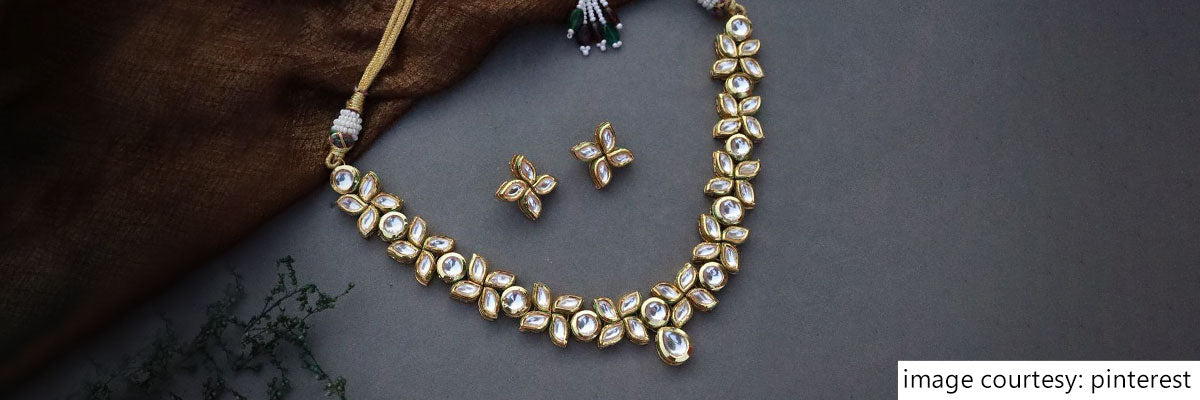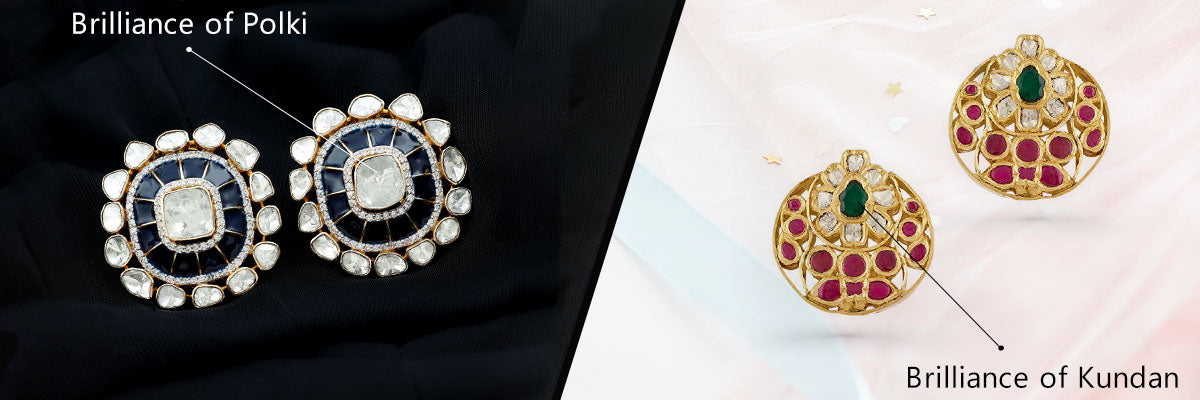The Polki and Kundan jewellery appeals to lovers of traditional Indian jewellery for all the best reasons. Timeless jewellery originated some centuries ago in the Mughal era. Subsequently, was adopted by the royal courts and their families. The commercialization of this art brought jewellery accessible to the common man. Since then, it has been on every jewellery lover’s must-have list.
That said, many find it hard to discern Polki and Kundan. So, we decided to shed some light on this and acquaint you with the important difference between polki and Kundan jewellery.
Let’s begin with the basic questions that you might be eager to seek answers to.
What is Polki Jewellery?

In simplest terms, polki refers to an uncut diamond, i.e., a diamond in its most natural and raw form. Let’s understand it this way. Usually, the diamonds that are used in modern jewellery undergo several stages of processing to take the shape and sparkle they are known for. However, the polki retains its rough original version, which means a polki is not exposed to any artificial treatment like polished diamonds.
To sum up, polki is untreated to an extent that they are not even cut, polished, or faceted. They are pure diamonds that are backed up with a gold foil that lends them a brilliant sheen. It carries high diamond and gold content, which adds more value to this old form of jewellery.
Polki has always been a revered form of traditional jewellery for centuries. Its old-world and royal aesthetics have gained it a new-found popularity among modern bride-to-be. Today, owning polki jewellery is considered a valuable addition to a bride’s jewellery assortment.
What is Kundan Jewellery?

Often polki and Kundan are used interchangeably. But it is essentially important to understand that they are different from each other.
Kundan jewellery is made using pieces of glass or glass stones that are impeccably cut and polished. Therefore, they lack the rawness and conventional charm of polki.
Traditionally, Kundan refers to the highly refined pure gold that is beaten up into thin pliable strips and shaped into the desired form to create the base. Thus, the 24 karats gold foiling on the base to secure the stones firmly is called Kundan.
Since Kundan jewellery is not about gold anymore, many jewellers use silver foiling or faux metal to cut costs, which has significantly reduced its importance to traditional jewellery.
Having understood the definitions of Kundan and polki, it’s time to delve a little more into the difference between polki and Kundan Jewellery
First Things First. Let’s Talk about the Cost:
Typically, Jewelers consider a few factors to ascertain the price of polki. Clarify and Carat remains the essential determinant of its value.
Since real polki jewellery has the purest form of diamonds, polki is quite expensive. Thankfully, it has a huge resale value, which makes it a classic investment for every jewellery enthusiast.
Apart from that, polki carries a sentimental value as a piece of jewellery that is lovingly passed down from generation to generation. Kundan, on the other hand, is relatively inexpensive, since it uses glass pieces instead of uncut diamonds. However, it does not possess the unmatched raw allure and conventional beauty of real polki jewellery, which makes it a precious asset.
Now what sparkles more? Polki or Kundan?

The obvious difference between Polki and Kundan jewellery is its brilliance. Since polki is untouched by any treatment, they have a high brilliance and sparkle than Kundan. It reflects light when set on a gold foil, that captivates every eye. On the other hand, Kundan does not possess a sheen as it is made of glass stones. Therefore, if you look closely at real polki jewellery, it has an inherent natural shine, that is not present in Kundan jewellery.


